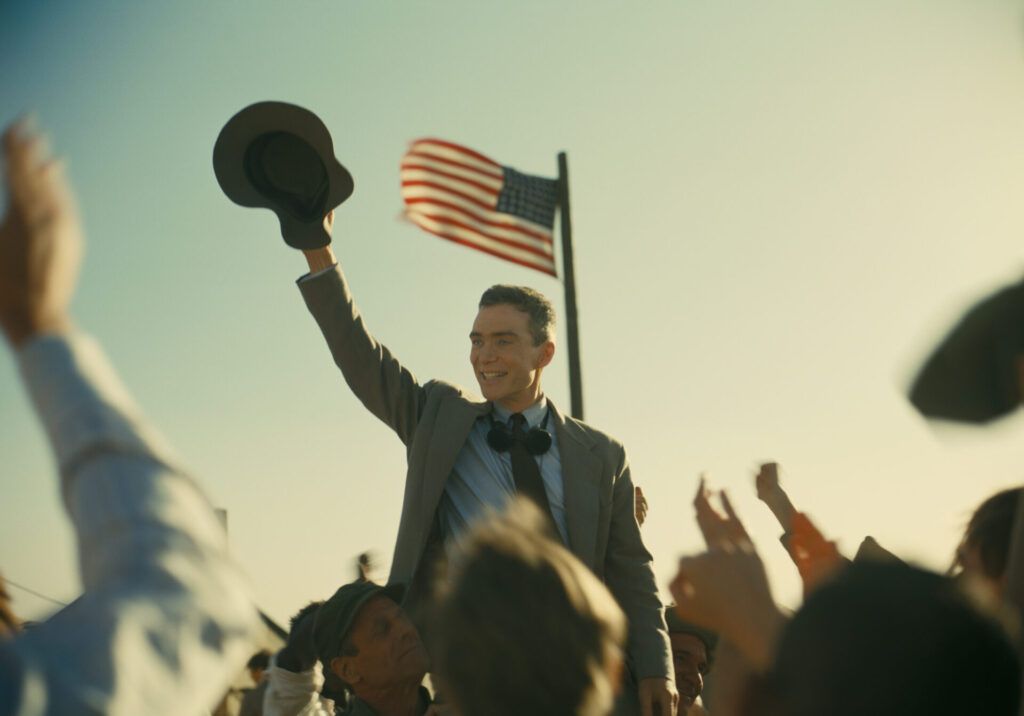What ‘Oppenheimer’ can teach today’s scientists
By Charles D. Ferguson | August 12, 2023
 J. Robert Oppenheimer (as portrayed by actor Cillian Murphy) is cheered by scientists of the Los Alamos Laboratory after the successful Trinity test in a scene from Christopher Nolan's film 'Oppenheimer' (Image courtesy of Universal Pictures)
J. Robert Oppenheimer (as portrayed by actor Cillian Murphy) is cheered by scientists of the Los Alamos Laboratory after the successful Trinity test in a scene from Christopher Nolan's film 'Oppenheimer' (Image courtesy of Universal Pictures)
As a scientist, I found the Oppenheimer film’s depiction of scientists refreshing and exhilarating. Scientists are shown as people with passion, as citizens committed to great causes, and as human beings with flaws and emotional complexity. Ultimately, the film has lessons for the roles and responsibilities of scientists in society.
The first part of the film does a fantastic job conveying the excitement of intellectual discovery. A young man, J. Robert Oppenheimer, leaves America for Europe on an adventure in hot pursuit of knowledge about the “new physics,” quantum mechanics. We see him seizing opportunities by meeting and learning from the top physicists in Europe, forming friendships with American and European scientists that will be foundational for his leadership in the Manhattan Project in the decades to come. We also see Oppenheimer learning Dutch in six weeks to give a lecture in the Netherlands on quantum physics, reading avant garde literature, for example, T.S. Eliot’s The Wasteland, and viewing modern art by Pablo Picasso. Armed with this knowledge and professional connections, Oppenheimer returns to America to found what Hans Bethe, a colleague and Nobel laureate in physics, would call decades later “the greatest school of theoretical physics that the United States has ever known.”[1]
But all is not perfect in this scientific Garden of Eden depicted in this part of the film. Angry at his instructor for making him redo an experiment, Oppenheimer injects potassium cyanide in an apple placed on the instructor’s desk. Oppenheimer awakens the next morning realizing that he has done an immoral act. He races to the laboratory and in the nick of time knocks away the apple before Niels Bohr takes a bite. This episode foreshadows even more dire moral dilemmas. The shape of the apple resembles the Gadget, the atomic bomb detonated at the Trinity test.
The film shows the scientists wrestling in various ways with the implications of their work on nuclear weapons. Physicist Isidor Rabi says to Oppenheimer: “You drop a bomb, and it falls on the just and the unjust. I don’t wish the culmination of three centuries of physics to be a weapon of mass destruction.” Many of the Chicago group of Manhattan Project scientists sign and circulate the Szilard petition, which was a moral plea to not use the bomb against Japan. The film shows Oppenheimer knocking the petition out of the hands of one of the scientists. Oppenheimer became committed then and in the several years to come to playing the role of the wise scientist advising government.
Much of the final part of the movie is devoted to the hearing deciding on whether Oppenheimer would have his security clearance renewed. In this ordeal, he witnesses who is for and against him. Edward Teller, who had campaigned for development of the “Super” or hydrogen bomb during and after the Manhattan Project, turns against Oppenheimer and represents the view that more powerful weapons are needed for national security.
The film shows Oppenheimer struggling with the moral implications of nuclear weapons. While he praises the amazing technical work of the workers at Los Alamos in a speech after the atomic bombings in Japan, the film at the same time depicts Oppenheimer visualizing audience members’ skin burning and melting from their bodies. In that scene, most people appear ecstatic about the results of the bombings, but one person is shown vomiting. In an earlier scene prior to the bombings, a group of Los Alamos scientists convene to question whether the weapons should be used against Japan. Oppenheimer supports use after weighing several options. After the war in his role on the General Advisory Committee to the Atomic Energy Commission, Oppenheimer argues against development of the hydrogen bomb, fearing it could spark an even greater arms race with the Soviets. But notably at the time of the hearing he is still in favor of fission weapons, which are a thousand times less powerful than hydrogen bombs.
What is the lesson of Oppenheimer for today’s scientists?
Scientists cannot turn back to an idyllic scientific Garden of Eden where research is pure and unencumbered with consequences for life and death decisions. They need to take part in the public arena.
The film highlights various role models. Scientists from the Chicago group founded the Bulletin of the Atomic Scientists; scientists mostly from the Los Alamos group as well as other parts of the Manhattan Project founded the Federation of Atomic Scientists, which soon was rebranded as the Federation of American Scientists. The National Academy of Sciences, founded in 1863 during the Civil War to provide scientific advice to the government, had many prominent Manhattan Project scientists as members, including Oppenheimer, Teller, Bethe, Ernest Lawrence, and George Kistiakowsky, who all influenced government policy.
Today, the National Academies of Sciences, Engineering, and Medicine continues to advise government with numerous consensus studies by committees of volunteer experts. Several current and recent National Academies studies relate to the legacy of the Manhattan Project, including the potential environmental effects of nuclear war, strategies against weapons of mass destruction terrorism, risk analysis methods for nuclear war and nuclear terrorism, and the review of the analysis of supplemental treatment of low-activity waste at the Hanford nuclear reservation.
The meaning of Oppenheimer’s life and work lives on for scientists and is brilliantly portrayed in the film.
Notes
[1] H. A. Bethe, Biographical memoir of J. Robert Oppenheimer, National Academy of Sciences, 1997, http://www.nasonline.org/publications/biographical-memoirs/memoir-pdfs/oppenheimer-j-robert.pdf
Together, we make the world safer.
The Bulletin elevates expert voices above the noise. But as an independent nonprofit organization, our operations depend on the support of readers like you. Help us continue to deliver quality journalism that holds leaders accountable. Your support of our work at any level is important. In return, we promise our coverage will be understandable, influential, vigilant, solution-oriented, and fair-minded. Together we can make a difference.















By Chris Griffith
A Manhattan Project historian comments on ‘Oppenheimer’
By Andrew Facini
Oppenheimer’s vision for arms control is still upon us
By Stewart Prager
‘Oppenheimer’ is terrific. But it’s just a movie
By Victor Gilinsky
Thought-provoked by ‘Oppenheimer’
By Daryl G. Kimball
‘Oppenheimer’, the bomb, and arms control, then and now
By Laura Grego
‘Oppenheimer’ depicts a man becoming powerful—and irrelevant
By Lisbeth Gronlund
Nuclear weapons since Oppenheimer: Who’s in control?
By Charles D. Ferguson
What ‘Oppenheimer’ can teach today’s scientists
By Lovely Umayam
Nolan’s ‘Oppenheimer’: an artistic visual tapestry of the bomb’s science and power intricacies
By Robert J. Goldston
Widening the field of view on ‘Oppenheimer’